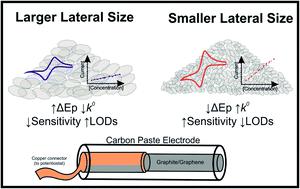当前位置:
X-MOL 学术
›
Anal. Methods
›
论文详情
Our official English website, www.x-mol.net, welcomes your
feedback! (Note: you will need to create a separate account there.)
The influence of lateral flake size in graphene/graphite paste electrodes: an electroanalytical investigation
Analytical Methods ( IF 2.7 ) Pub Date : 2020-04-03 , DOI: 10.1039/d0ay00169d Alejandro García-Miranda Ferrari 1, 2, 3, 4 , Hadil M. Elbardisy 1, 2, 3, 4, 5 , Valentine Silva 1, 2, 3, 4 , Tarek S. Belal 6, 7, 8, 9, 10 , Wael Talaat 5, 7, 10, 11, 12 , Hoda G. Daabees 7, 10, 11, 12, 13 , Craig E. Banks 1, 2, 3, 4 , Dale A. C. Brownson 1, 2, 3, 4
Analytical Methods ( IF 2.7 ) Pub Date : 2020-04-03 , DOI: 10.1039/d0ay00169d Alejandro García-Miranda Ferrari 1, 2, 3, 4 , Hadil M. Elbardisy 1, 2, 3, 4, 5 , Valentine Silva 1, 2, 3, 4 , Tarek S. Belal 6, 7, 8, 9, 10 , Wael Talaat 5, 7, 10, 11, 12 , Hoda G. Daabees 7, 10, 11, 12, 13 , Craig E. Banks 1, 2, 3, 4 , Dale A. C. Brownson 1, 2, 3, 4
Affiliation

|
We report the electroanalytical properties of graphene and graphite paste electrodes comprising varying lateral flake sizes. The fabricated electrodes are first electrochemically validated using a standard redox probe prior to the influence of their heterogeneous electron transfer (HET) kinetics/flake sizes being explored towards sensing applications. Electrochemical analysis is employed using a range of relevant biomolecules and prominent drugs of abuse. It is inferred that smaller lateral flake sizes result in an increased number of edge plane sites ‘available’ upon the electrode surface, leading to greater sensitivity and Limit of Detection (LOD) values. Calibration plots show an improvement in LODs from 0.7 to 0.19 μM and sensitivity from 0.023 to 0.038 A M−1 for the detection of ascorbic acid and LODs from 3.43 to 1.3 μM and sensitivities from 0.009 to 0.025 A M−1 for the detection of β-nicotinamide adenine dinucleotide (NADH) when comparing ‘typical’ (12.2 μm) and ‘small’ (0.5 μm) lateral flake sizes. In the case of uric acid, the reported sensitivity and LOD with typical sizes is 0.046 A M−1 and 1.42 μM, in comparison to 0.168 A M−1 and 0.85 μM with smaller flakes, with dopamine also supporting these findings. In terms of the drugs of abuse considered, methamphetamine exhibits an improved LOD from 0.82 to 0.65 μg mL−1 and sensitivity from 0.15 to 0.25 A μg mL−1 when comparing typical and small flakes respectively. However, cocaine and 3,4-methylenedioxymethamphetamine (MDMA) exhibit variable results, likely due to complex oxidation mechanisms and each paste electrode's specific heterogeneous surface nature. This work demonstrates the sensing capabilities of graphene and graphite paste electrodes comprising varying lateral flake sizes. It is inferred that smaller lateral flake sizes give rise to improved electroanalytical responses and enhanced graphitic based electrochemical sensors; which is important to consider when designing and optimising carbon based electrochemical sensor devices and likely has wider implications in the energy sector when utilising such electrodes.
中文翻译:

石墨烯/石墨糊状电极中薄片横向尺寸的影响:电分析研究
我们报告了石墨烯和石墨糊电极的电分析性能,其中包括不同的横向薄片尺寸。首先,使用标准的氧化还原探针对制成的电极进行电化学验证,然后研究其异质电子传递(HET)动力学/薄片尺寸对传感应用的影响。使用一系列相关的生物分子和重要的滥用药物进行电化学分析。可以推断出,较小的横向薄片尺寸会导致在电极表面“可用”的边缘平面部位数量增加,从而导致更高的灵敏度和检测极限(LOD)值。校准图显示LOD从0.7改善到0.19μM,灵敏度从0.023改善到0.038 AM -1当比较“典型”(12.2μm)和“小”(0.5μm)时,检测3.43至1.3μM的抗坏血酸和LOD以及检测0.009至0.025 AM -1的灵敏度,用于检测β-烟酰胺腺嘌呤二核苷酸(NADH) )侧片尺寸。对于尿酸,报道的典型大小的灵敏度和LOD为0.046 AM -1和1.42μM,而薄片较小的为0.168 AM -1和0.85μM,多巴胺也支持这些发现。就所考虑的滥用药物而言,甲基苯丙胺的LOD从0.82提高至0.65μgmL -1,灵敏度从0.15至0.25 AμgmL -1分别比较典型薄片和小薄片时。但是,可卡因和3,4-亚甲二氧基甲基苯丙胺(MDMA)表现出可变的结果,这可能是由于复杂的氧化机制和每个糊状电极的特定异质表面性质所致。这项工作演示了石墨烯和石墨糊状电极的感应能力,这些电极具有不同的横向薄片尺寸。可以推断出,较小的侧向薄片尺寸可以改善电分析响应并增强基于石墨的电化学传感器。在设计和优化基于碳的电化学传感器设备时,必须考虑到这一点,并且在使用此类电极时可能会对能源领域产生更广泛的影响。
更新日期:2020-04-03
中文翻译:

石墨烯/石墨糊状电极中薄片横向尺寸的影响:电分析研究
我们报告了石墨烯和石墨糊电极的电分析性能,其中包括不同的横向薄片尺寸。首先,使用标准的氧化还原探针对制成的电极进行电化学验证,然后研究其异质电子传递(HET)动力学/薄片尺寸对传感应用的影响。使用一系列相关的生物分子和重要的滥用药物进行电化学分析。可以推断出,较小的横向薄片尺寸会导致在电极表面“可用”的边缘平面部位数量增加,从而导致更高的灵敏度和检测极限(LOD)值。校准图显示LOD从0.7改善到0.19μM,灵敏度从0.023改善到0.038 AM -1当比较“典型”(12.2μm)和“小”(0.5μm)时,检测3.43至1.3μM的抗坏血酸和LOD以及检测0.009至0.025 AM -1的灵敏度,用于检测β-烟酰胺腺嘌呤二核苷酸(NADH) )侧片尺寸。对于尿酸,报道的典型大小的灵敏度和LOD为0.046 AM -1和1.42μM,而薄片较小的为0.168 AM -1和0.85μM,多巴胺也支持这些发现。就所考虑的滥用药物而言,甲基苯丙胺的LOD从0.82提高至0.65μgmL -1,灵敏度从0.15至0.25 AμgmL -1分别比较典型薄片和小薄片时。但是,可卡因和3,4-亚甲二氧基甲基苯丙胺(MDMA)表现出可变的结果,这可能是由于复杂的氧化机制和每个糊状电极的特定异质表面性质所致。这项工作演示了石墨烯和石墨糊状电极的感应能力,这些电极具有不同的横向薄片尺寸。可以推断出,较小的侧向薄片尺寸可以改善电分析响应并增强基于石墨的电化学传感器。在设计和优化基于碳的电化学传感器设备时,必须考虑到这一点,并且在使用此类电极时可能会对能源领域产生更广泛的影响。











































 京公网安备 11010802027423号
京公网安备 11010802027423号